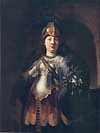Rembrandt van
Rijn
Selected Works: 1620-1635
Many writers, in attempting to describe the nature of Rembrandt's genius, have compared him to Shakespeare. Roger Fry in The Arts of Painting and Sculpture says that Rembrandt has a unique place in the history of European art because 'he united in his spirit a dramatic and psychological imagination of Shakespearian intensity and an equally great plastic imagination'. It would be contrived and unhelpful to press of the comparison too for; indeed there were radical differences between the philosophies of the two men as G. Knuttel Wzn. points out. Yet Knuttel goes on to say that 'No artist before Rembrandt has researched and understood the human soul and so movingly and convincingly attested to it as Shakespeare'.
Writers tend to reach for Shakespeare's name when describing Rembrandt for several reasons. First, of course, a Titan, in art as in other spheres, can only be compared with another-and there are few of these to choose from. Secondly, and more constructively, the two artists are comparable in the breadth of their understanding and their sympathy for the human condition. Thirdly, and growing out of the last point, they share the quality of universality.
Rembrandt, like Shakespeare uses his art to convey ideas which apply to human beings of all times and all cultures. Great art is, in this sense, timeless. Élie Faure, the French art critic and historian, wrote this of Rembrandt and his work: 'His humanity is truly formidable, it is fatal like lament, love; change continues, indifferent and dramatic, between all that is born and all that dies. He follows our steps to death in the traces of blood which mark them. He does not pity us, he does not comfort us, because he is with us, because he is us.' *
click here for the complete online catalogue of Rembrandt's painting

















































